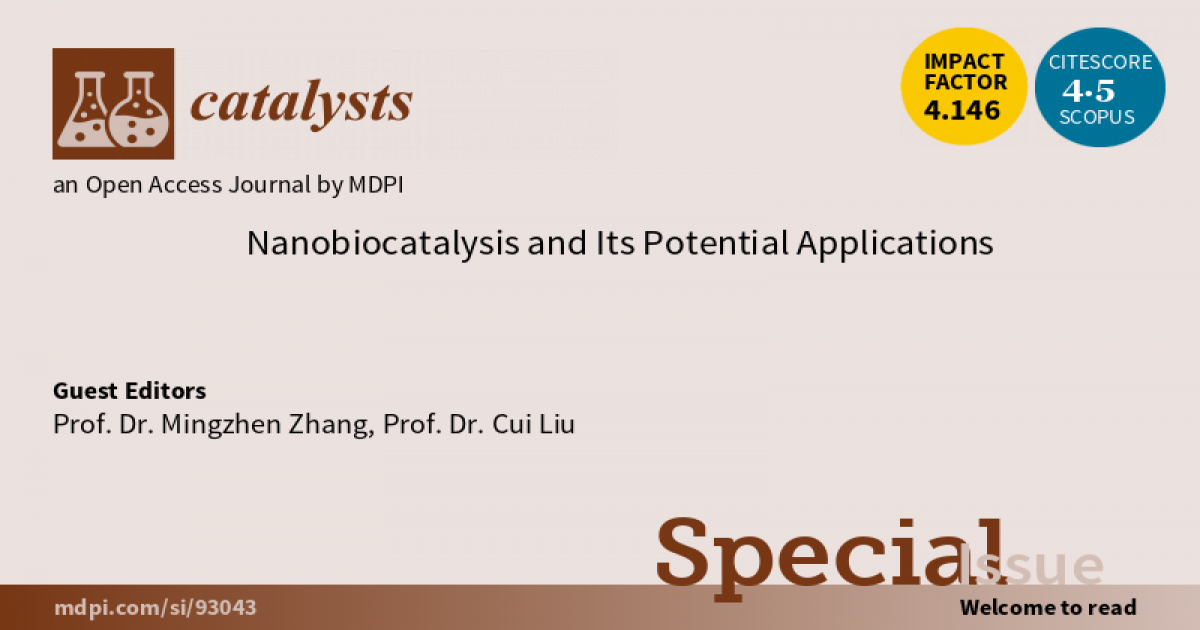- 4.0Impact Factor
- 7.6CiteScore
- 17 daysTime to First Decision
Nanobiocatalysis and Its Potential Applications
This special issue belongs to the section “Biocatalysis“.
Special Issue Information
Dear Colleagues,
Nanozymes are nanomaterials with intrinsic enzyme-like characteristics that have been booming over the past decade because of their capability to address the limitations of natural enzymes, such as low stability, high cost, and difficult storage. Along with the rapid development and ever-deepening understanding of nanoscience and nanotechnology, nanozymes hold promise to serve as direct surrogates of traditional enzymes by mimicking and further engineering the active centers of natural enzymes. This call includes nanozymes and their biological applications. We are interested in, among others, the design, synthesis, and catalytic mechanism of nanozymes, nanozymes in the detection of pathogenic microorganisms, biomarkers for diseases, and therapeutic applications of nanozymes for antibacterial, anti-inflammation, and anticancer purposes.
Prof. Dr. Mingzhen Zhang
Prof. Dr. Cui Liu
Guest Editors
Manuscript Submission Information
Manuscripts should be submitted online at www.mdpi.com by registering and logging in to this website. Once you are registered, click here to go to the submission form. Manuscripts can be submitted until the deadline. All submissions that pass pre-check are peer-reviewed. Accepted papers will be published continuously in the journal (as soon as accepted) and will be listed together on the special issue website. Research articles, review articles as well as short communications are invited. For planned papers, a title and short abstract (about 250 words) can be sent to the Editorial Office for assessment.
Submitted manuscripts should not have been published previously, nor be under consideration for publication elsewhere (except conference proceedings papers). All manuscripts are thoroughly refereed through a single-blind peer-review process. A guide for authors and other relevant information for submission of manuscripts is available on the Instructions for Authors page. Catalysts is an international peer-reviewed open access monthly journal published by MDPI.
Please visit the Instructions for Authors page before submitting a manuscript. The Article Processing Charge (APC) for publication in this open access journal is 2200 CHF (Swiss Francs). Submitted papers should be well formatted and use good English. Authors may use MDPI's English editing service prior to publication or during author revisions.
Keywords
- Nanozymes
- Design, synthesis, and catalytic mechanism of nanozymes
- Rapid detection technology
- Antibacterial
- Anti-inflammation
- Anticancer

Benefits of Publishing in a Special Issue
- Ease of navigation: Grouping papers by topic helps scholars navigate broad scope journals more efficiently.
- Greater discoverability: Special Issues support the reach and impact of scientific research. Articles in Special Issues are more discoverable and cited more frequently.
- Expansion of research network: Special Issues facilitate connections among authors, fostering scientific collaborations.
- External promotion: Articles in Special Issues are often promoted through the journal's social media, increasing their visibility.
- e-Book format: Special Issues with more than 10 articles can be published as dedicated e-books, ensuring wide and rapid dissemination.

